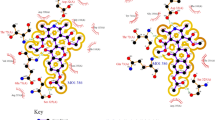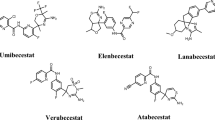Abstract
β-site amyloid precursor protein cleaving enzyme (BACE-1) is a validated target for Alzheimer therapy due to its distinctive role in pathogenesis of AD. In the present contribution, a series of new 3,5-bis-N-(aryl/heteroaryl) carbamoyl-4-aryl-1,4-dihydropyridine structures were synthesized as BACE-1 inhibitors (6a–6n). In vitro BACE-1 inhibitory activities were determined by enzymatic fluorescence resonance energy transfer assay. Synthesized dihydropyridine (DHP) analogues exhibited weak to good inhibitory activities while 6i, 6n and 6a were found to be the most potent molecules with 83.76, 79.45 and 72.47 % BACE-1 inhibition at 10 μM, respectively. Structure binding/activity relationship elucidations revealed that superior BACE-1 inhibitory activities were observed for DHP derivatives bearing fused/non-fused thiazole groups and particularly 3,5-bis-N-(6-ethoxy-2-benzothiazolyl) moiety. Binding maps showed that enhanced activity may be attributed to the additional H-bond and hydrophobic interactions with S2–S3 subpockets of BACE-1.







Similar content being viewed by others
References
Al-Nadaf, A., G. Abu Sheikha, and M.O. Taha. 2010. Elaborate ligand-based pharmacophore exploration and QSAR analysis guide the synthesis of novel pyridinium-based potent beta-secretase inhibitory leads. Bioorganic and Medicinal Chemistry 1(18): 3088–3115.
Biran, Y., C.L. Masters, K.J. Barnham, A.I. Bush, and P.A. Adlard. 2009. Pharmacotherapeutic targets in Alzheimer’s disease. Journal of Cellular and Molecular Medicine 13(1): 61–86.
Choi, S.J., J.H. Cho, I. Im, S.D. Lee, J.Y. Jang, Y.M. Oh, Y.K. Jung, E.S. Jeon, and Y.C. Kim. 2010. Design and synthesis of 1,4-dihydropyridine derivatives as BACE-1 inhibitors. European Journal of Medicinal Chemistry 45(6): 2578–2590.
Citron, M. 2010. Alzheimer’s disease: strategies for disease modification. Nature Reviews Drug Discovery 9: 387–398.
Clemens, R.J., and J.A. Hyatt. 1985. Acetoacetylation with 2,2,6-trimethyl-4H-1,3-dioxin-4-one: a convenient alternative to diketene. Journal of Organic Chemistry 50: 2431–2433.
Creed, M.C., and N.W. Milgram. 2010. Amyloid-modifying therapies for Alzheimer’s disease: therapeutic progress and its implications. Age 32(3): 365–384.
Edraki, N., O. Firuzi, A. Foroumadi, R. Miri, A. Madadkar-Sobhani, M. Khoshneviszadeh, and A. Shafiee. 2013. Phenylimino-2H-chromen-3-carboxamide derivatives as novel small molecule inhibitors of β-Secretase (BACE1). Bioorganic and Medicinal Chemistry 21(8): 2396–2412.
Gaulton, A., L.J. Bellis, A.P. Bento, J. Chambers, M. Davies, A. Hersey, Y. Light, S. McGlinchey, D. Michalovich, and B. Al-Lazikani. 2012. ChEMBL: a large-scale bioactivity database for drug discovery. Nucleic Acids Research 40(D1): D1100–D1107.
Ghosh, A.K., M. Brindisi, and J. Tang. 2012. Developing β-secretase inhibitors for treatment of Alzheimer’s disease. Journal of Neurochemistry 1: 71–83.
Hantzsch, A. 1882. Ueber die synthese pyridinartiger verbindungen aus acetessigÃther und aldehydammoniak. Liebigs Annalen der Chemie 215(1): 1–82.
Huang, W.H., R. Sheng, and Y.Z. Hu. 2009. Progress in the development of nonpeptidomimetic BACE 1 inhibitors for Alzheimers disease. Current Medicinal Chemistry 16(14): 1806–1820.
Jorgensen, W. 2014. The many roles of computation in drug discovery. Science 303: 1813–1818.
Laurie, R., T. Alasdair, and R.M. Jackson. 2006. Methods for the prediction of protein-ligand binding sites for structure-based drug design and virtual ligand screening. Current Protein and Peptide Science 7(5): 395–406.
Luo, Y., B. Bolon, S. Kahn, B.D. Bennett, S. Babu-Khan, P. Denis, W. Fan, H. Kha, J. Zhang, and Y. Gong. 2001. Mice deficient in BACE1, the Alzheimer’s beta-secretase, have normal phenotype and abolished beta-amyloid generation. Nature Neuroscience 4(3): 2001–2003.
Morris, G.M., R. Huey, W. Lindstrom, M.F. Sanner, R.K. Belew, D.S. Goodsell, and A.J. Olson. 2009. AutoDock4 and AutoDockTools4: automated docking with selective receptor flexibility. Journal of Computational Chemistry 30(16): 2785–2791.
Nussbaum, R.L., and C.E. Ellis. 2003. Alzheimer’s disease and Parkinson’s disease. New England Journal of Medicine 348: 1356–1364.
Putta, S., and P. Beroza. 2007. Shapes of things: computer modeling of molecular shape in drug discovery. Current Topics in Medicinal Chemistry 7(15): 1514–1524.
Razzaghi-Asl, N., O. Firuzi, B. Hemmateenejad, K. Javidnia, N. Edraki, and R. Miri. 2013. Design and synthesis of Novel 3,5-bis-N-(aryl/heteroaryl) carbamoyl-4-aryl-1,4-dihydropyridines as small molecule BACE-1 inhibitors. Bioorganic and Medicinal Chemistry 21(22): 6893–6909.
Sellers, R.P., L.D. Alexander, V.A. Johnson, C.C. Lin, J. Savage, R. Corral, J.T. Moss, S. Slugocki, E.K. Singh, and M.R. Davis. 2010. Design and synthesis of Hsp90 inhibitors: exploring the SAR of Sansalvamide A derivatives. Bioorganic and Medicinal Chemistry Letter 18: 6822–6856.
Van Der Spoel, D., E. Lindahl, B. Hess, G. Groenhof, A.E. Mark, and H.J.C. Berendsen. 2005. GROMACS: fast, flexible, and free. Journal of Computational Chemistry 26: 1701–1718.
Wallace, A.C., R.A. Laskowski, and J.M. Thornton. 1995. LIGPLOT: a program to generate schematic diagrams of protein-ligand interactions. Protein Engineering 8: 127–134.
Yan, R., M.J. Bienkowski, M.E. Shuck, H. Miao, M.C. Tory, A.M. Pauley, J.R. Brashler, N.C. Stratman, W.R. Mathews, A.E. Buhl, D.B. Carter, A.G. Tomasselli, L.A. Parodi, R.L. Heinrikson, and M.E. Gurney. 1999. Membrane-anchored aspartyl protease with Alzheimer’s disease [beta]-secretase activity. Nature 402: 533–537.
Zuo, Z., X. Luo, W. Zhu, J. Shen, X. Shen, H. Jiang, and K. Chen. 2005. Molecular docking and 3D-QSAR studies on the binding mechanism of statine-based peptidomimetics with β-secretase. Bioorganic and Medicinal Chemistry 13: 2121–2131.
Acknowledgments
This work was financially supported by research council of Shiraz University of Medical Sciences.
Author information
Authors and Affiliations
Corresponding author
Rights and permissions
About this article
Cite this article
Miri, R., Firuzi, O., Razzaghi-Asl, N. et al. Inhibitors of Alzheimer’s BACE-1 with 3,5-bis-N-(aryl/heteroaryl) carbamoyl-4-aryl-1,4-dihydropyridine structure. Arch. Pharm. Res. 38, 456–469 (2015). https://doi.org/10.1007/s12272-014-0401-x
Received:
Accepted:
Published:
Issue Date:
DOI: https://doi.org/10.1007/s12272-014-0401-x




